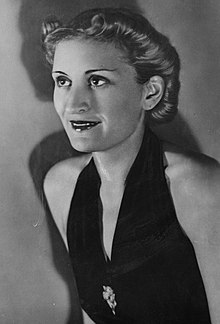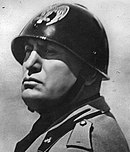Edda Mussolini
Edda Ciano | |
|---|---|
 | |
| Born | Edda Mussolini 1 September 1910 |
| Died | 9 April 1995 (aged 84) |
| Title | Countess of Cortellazzo and Buccari |
| Spouse | |
| Children | 3 |
| Parents |
|
Edda Ciano, Countess of Cortellazzo and Buccari (née Mussolini; 1 September 1910 – 9 April 1995) was the daughter of
Biography
Early life
She was born out of wedlock to Benito Mussolini and Rachele Guidi in Forlì, Romagna. Her parents did not marry until December 1915. In her early years, while her father was editor of Il Popolo d'Italia in Milan, Edda lived with Rachele in Forlì. Her father became Prime Minister of Italy in October 1922 and dictator after January 1925.
In March 1925, Rachele and Edda with her brothers and sisters, moved from
Her husband was appointed
Second World War
After the Italian invasion of Albania in June 1939, the city of Santi Quaranta (Sarandë in Albanian) was renamed "Porto Edda."

In July 1939, she was depicted on the cover of Time in a feature entitled "Lady of the Axis".[3]
During the
It is rumored that Heinrich Himmler bestowed Edda the rank of an honorary SS leader (SS Ehrenführerin) in 1943.[5]
After Edda's close call in the Adriatic Sea, Rachele and Benito Mussolini were doubly distressed when her brother, Bruno, died in August of the same year.[4]
Execution of Ciano and escape to Switzerland
In July 1943, when internal opposition against Mussolini finally emerged in the
Edda Ciano escaped to Switzerland on 9 January 1944, disguised as a peasant woman. She managed to smuggle out the Count's wartime diaries, which had been hidden in her clothing by her confidant Emilio Pucci. At that time he was a lieutenant in the Italian Air Force but later found fame as a fashion designer.[7] War correspondent Paul Ghali of the Chicago Daily News learned of her secret internment in a Swiss convent in Neggio and arranged the publication of the diaries.[8] They reveal much of the secret history of the Fascist regime between 1939 and 1943 and are considered a prime historical source. The diaries are strictly political and contain little of the Cianos' personal lives.
After the war
After returning to Italy from Switzerland, Edda was arrested and held in detention on the island of Lipari. On 20 December 1945, she was sentenced to two years' imprisonment for aiding Fascism.[citation needed] Marcello Sorgi's book, Edda Ciano e il comunista (2009), concerns her time on Lipari and her relationship with a young communist who also lived there; this was the basis of a 2011 film starring Stefania Rocca.[9]
Her autobiography, La mia vita, was published in translation as My Truth by Weidenfeld & Nicolson in 1975.
At the age of 84, she died in Rome in 1995.[10]
Legacy
At the time, it was widely reported that the daughter of
Films depicting Edda include The Verona Trial (1963), starring Silvana Mangano,[12] and Mussolini and I (1985) in which she was played by Susan Sarandon.[13] In the TV-series Mussolini: The Untold Story (1985), Mary Elizabeth Mastrantonio played Edda.[14] The Verona Trial, about Ciano's death sentence, was banned in Venice after the widowed countess lodged a complaint with the prefect, saying that the film was inaccurate and "treads on our sorrow".[15]
Her son Fabrizio Ciano wrote a personal memoir titled Quando il nonno fece fucilare papà (When Grandpa Had Daddy Shot).[16]
Honors
Sources
- Bosworth, R.J.B. (2002). Mussolini, Hodder Arnold ISBN 0-340-73144-3
- Ciano, Fabrizio (1991). Quando il nonno fece fucilare papà (When Grandpa Had Daddy Shot). Milan: Mondadori.
- Ciano, Galeazzo (1948). Ciano's Diplomatic Papers: being a record of nearly 200 conversations held during the years 1936-42 with Hitler, Mussolini, Franco; together with important memoranda, letters, telegrams etc.; edited by Malcolm Muggeridge; translated by Stuart Hood. London: Odhams Press.
- Ciano, Galeazzo (2000). The Ciano Diaries 1939-1943: The Complete, Unabridged Diaries of Count Galeazzo Ciano, Italian Minister of Foreign Affairs, 1936-1943 ISBN 1-931313-74-1
- Чиано Галеаццо, Дневник фашиста. 1939-1943, (Москва: Издательство "Плацъ", Серия "Первоисточники новейшей истории", 2010, 676 стр.) ISBN 978-5-903514-02-1
- Guerri, Giordano Bruno (2005). Un amore fascista. Benito, Edda e Galeazzo. Mondadori ISBN 88-04-53467-2
- Malaparte, Curzio, Kaputt: After he wrote Coup d'État: The Technique of Revolution, Malaparte was jailed by the fascist regime. He was freed on the personal intervention of Count Galeazzo Ciano. In Kaputt Malaparte refers to Count Ciano and his wife Edda. Like Edda Ciano, Malaparte spent time in forced exile on the island of Lipari.
- Moseley, Ray (1999). Mussolini's Shadow: The Double Life of Count Galeazzo Ciano. Yale University Press ISBN 0-300-07917-6
- Mussolini, Rachele (1974). Mussolini: An Intimate Biography by His Widow (as told to Albert Zarca). New York: William Morrow. pp. 291. ISBN 0-688-00266-8.
- Ridley, Jasper (1997). Mussolini. St. Martin's Press.
- Salter, Michael, and Lorie Charlesworth, "Ribbentrop and the Ciano Diaries at the Nuremberg Trial" in Journal of International Criminal Justice 2006 4(1):103-127
References
- ISSN 0362-4331. Retrieved 18 October 2017.
- ISBN 978-0-679-44980-5.
- ^ "Edda Ciano". Time. 24 July 1939. cover. Archived from the original on 14 June 2007.
- ^ a b Mussolini/Zarca, Mussolini, p. 86
- ^ Akten des RFSS, Filmrolle 33, bei Höhne, S. 129, Anmerkung 21 auf Seite 549
- ^ Mack Smith, Denis (1959). Italy: A Modern History. Ann Arbor: University of Michigan Press. p. 485.
- ^ McGaw Smyth, Howard (1969). "The Ciano Papers: Rose Garden". Central Intelligence Agency. Archived from the original on 9 April 2008. Retrieved 23 April 2008. Detailed CIA history of the events leading up to the Count's death and Edda's flight to Switzerland
- ISBN 978-1-4196-3639-4.
- ^ Castelli, Marco (11 March 2011). "Stefania Rocca è Edda la figlia del duce in tv". La Provincia (in Italian). Retrieved 14 March 2024.
- ^ Achtner, Wolfgang (17 April 1995). "Obituary: Edda Ciano". The Independent. Retrieved 15 March 2024.
- ^ "Lady of the Axis". Time. 24 July 1939. Archived from the original on 13 September 2012.
Herr & Frau Göring became her fast friends (they later named their daughter after her).
- ^ Lane, John Francis (15 October 2013). "Carlo Lizzani obituary". The Guardian. Retrieved 15 March 2024.
- ^ O'Connor, John J. (6 September 1985). "Decline and Fall of Mussolini Depicted on HBO". The New York Times. Retrieved 8 March 2024.
- ^ O'Connor, John J. (22 November 1985). "George C. Scott as Mussolini on NBC". The New York Times. Retrieved 14 March 2024.
- ^ "Ciano Film Banned in Venice". The Times. No. 55639. 2 March 1963. p. 7.
- ISBN 0-300-07917-6.
External links
- Edda with Raimonda, Marzio and Fabrizio (her three children from Count Galeazzo)
- Newspaper clippings about Edda Mussolini in the 20th Century Press Archives of the ZBW

